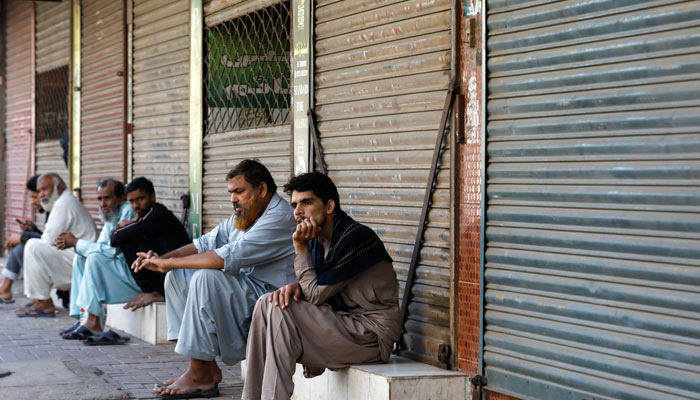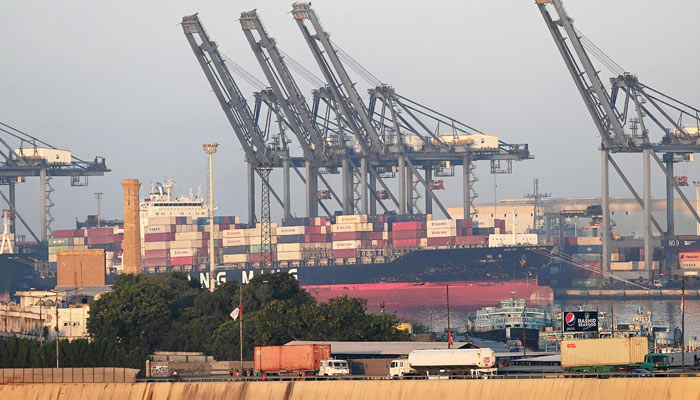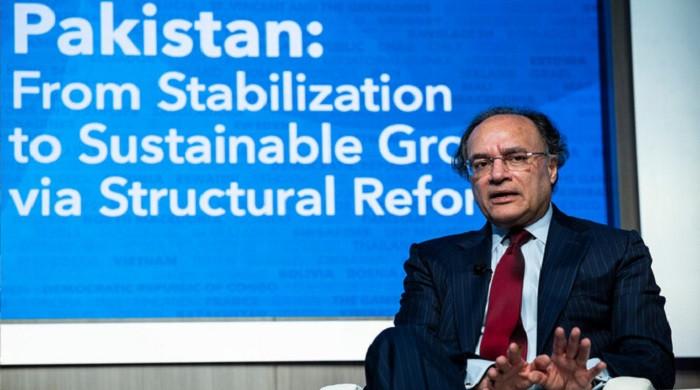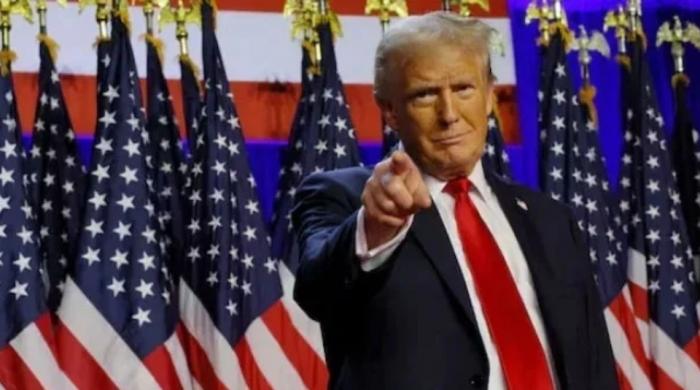Pakistan's risk of defaulting on its debt 'real', warns US think tank
USIP report states if Pakistan ultimately defaults, there will be a “cascade of disruptive effects”.
April 07, 2023

- Report says if Pakistan defaults, there will be a “cascade of disruptive effects”.
- From April 2023 to June 2026, Pakistan needs to repay $77.5bn in external debt.
- “Given Pakistan’s demographic profile, crisis could go in unexpected directions,” it states.
A Washington-based think tank, the United States Institute of Peace (USIP), has warned that there is “a real danger that Pakistan could default on debt”, which might further intensify political turmoil amid already surging terrorism.
The author of the analysis published on Thursday warned that amid skyrocketing inflation, political conflicts, and rising terrorism, the country is facing the risk of a default due to its massive external debt obligations.
The cash-strapped nation is reeling with the repercussions of a deepening political crisis — which initially began in April last year when former prime minister Imran Khan was ousted through a vote of no-confidence motion — and the derailment of the $6.5 billion International Monetary Fund (IMF) programme.
Islamabad has been hosting an IMF mission since late January to negotiate a series of policy measures to secure $1.1 billion in funding for the cash-strapped economy, which is on the verge of collapse.
The funds are part of a $6.5 billion bailout package the IMF approved in 2019, which analysts say is critical for Pakistan to avert defaulting on external payment obligations.
The deal will also unlock other bilateral and multilateral financing avenues for Pakistan to shore up its foreign exchange reserves, which have fallen to four weeks’ worth of import cover, and help it steer out of a balance of payment crisis.
The USIP report highlighted four factors that are important to consider if authorities want to pull Pakistan out of the economic abyss; these include:
- Composition of Pakistan’s overall external debt
- Repayment pressure on the debt in both short- and medium-term
- Potential inflows that can offset debt outflows
- Pakistan’s external debt management strategy
1. Debt composition
Pakistan holds external debt and liabilities worth $126.3 billion — as of December 2022 — out of this nearly 77% amounting to $97.5 billion is directly owned by the government to various creditors. Meanwhile an additional $7.9 billion is owned by government-controlled public sector enterprises to multilateral creditors.
It should be noted that Pakistan’s creditors fall under four broad categories:
- Multilateral debt
- Paris club debt
- Private and commercial loans
- Chinese debt
2. Short- and medium-term debt repayment pressure
The country’s large external debt comes with considerable repayment pressure. The US think tank report mentioned that from April 2023 to June 2026, Pakistan needs to repay $77.5 billion in external debt, which is a “hefty amount” for a $350 billion economy.
It should be noted that the major repayments in the next three years are to Chinese financial institutions, private creditors and Saudi Arabia.
The country faces near-term debt repayment pressure as the external debt servicing burden is $4.5 billion from April to June 2023.
The major repayments are due in June when a $1 billion Chinese SAFE deposit and a roughly $1.4 billion Chinese commercial loan would mature. Pakistani authorities hope to convince the Chinese to refinance and roll over both debts, something the Chinese government and commercial banks have done in the past.
However, even if Pakistan manages to meet these obligations, the next fiscal year will be more challenging, as the debt servicing will rise to nearly $25 billion. This includes:
1. $15 billion of short-term loans; which include:
- $4 billion Chinese SAFE deposits
- $3 billion Saudi deposits
- $2 billion UAE deposits
2. $7 billion in long-term debt; which includes:
- $1 billion repayment on a Eurobond in the fourth quarter
- $1.1 billion of long-term commercial loans to Chinese banks
The report forecast that in 2024-25, Pakistan’s debt servicing is likely to be around $24.6 billion, which includes $8.2 billion in long-term debt repayments and another $14.5 billion in short-term debt repayments; this includes major repayments to Chinese lenders of $3.8 billion.
In 2025-26, the debt servicing burden is likely to be at least $23 billion; that year Pakistan is to pay back $8 billion in long-term debt, including repaying $1.8 billion for a Eurobond and $1.9 billion to Chinese commercial lender.
3. Repayment calculus
The US think tank suggested that in order to repay its debt and avoid a sovereign default, Pakistan's earnings from exports, foreign direct investment (FDI) and remittances inflows are vital.
However, inflows from these three sources are projected to stay subdued compared to the import bill as well as the mounting debt repayment pressure.

Over the next three years, imports are likely to be higher than the total dollar amount of exports and remittances, which will lead to a current account deficit requiring external financing.
Meanwhile, FDI is projected to remain subdued as well. In recent years, investment has averaged a dismal $2 billion annually due to the challenging business environment and frequent policy changes; similar levels of investment are the best case for the next few years.
Investor sentiment has also been impacted by the government’s recent restrictions on the movement of capital outside the country.
4. Options to manage external debt
The report suggested that the economic managers of Pakistan has only two options to address its external debt burden. The first is to take fresh loans and seek rollovers of debt — however, the country’s ability to access the sovereign financing market is limited due to downgrades by international credit rating agencies.
Therefore, if the country seeks to avoid default the leadership will depend on Middle Eastern partners and China, not just for existing rollover but also fresh loans.
It should be noted that the details of these will depend on negotiations with the IMF. If the stalled IMF programme is revived, the amount will be smaller than the one it would seek if the programme collapses.
And in case the bailout programme is revived and completed over the summer, Pakistan will need a new IMF programme, in addition to new loans and rollovers from its Middle Eastern and Chinese partners, due to its external debt burden over the new three years.
The second option that the country has is that it seeks pre-emptive restructuring of debt as it will help reduce the repayment pressure and spare scarce dollars in the economy to finance the country’s current account deficit.
What will happen if Pakistan defaults?
The US think tank report mentioned that if Pakistan ultimately defaults, there will be a “cascade of disruptive effects”.
Primarily, the country’s imports could be disrupted, which could lead to a shortage of essential goods and commodities.
The nation of 220 million people, which is already seeing intense political conflict between the Pakistan Democratic Movement-led government and Pakistan Tehreek-e-Insaf (PTI), may also see the economic crisis creating more political turmoil.
“And given Pakistan’s demographic profile and surging terrorism threats, the resulting crisis could go in unexpected directions,” it stated.











